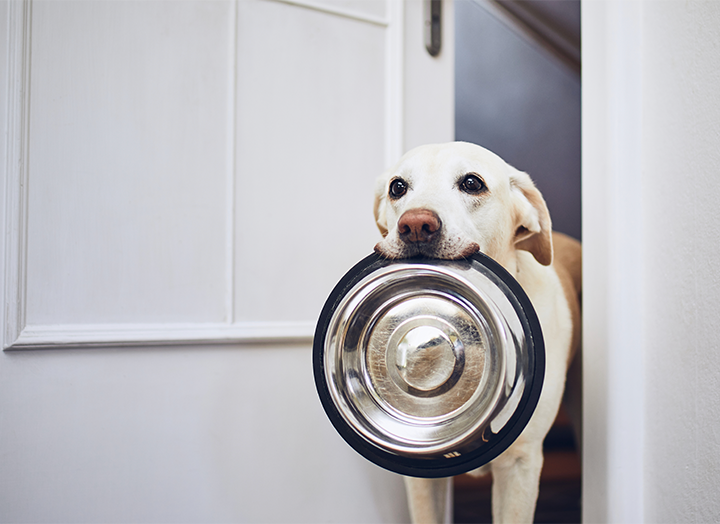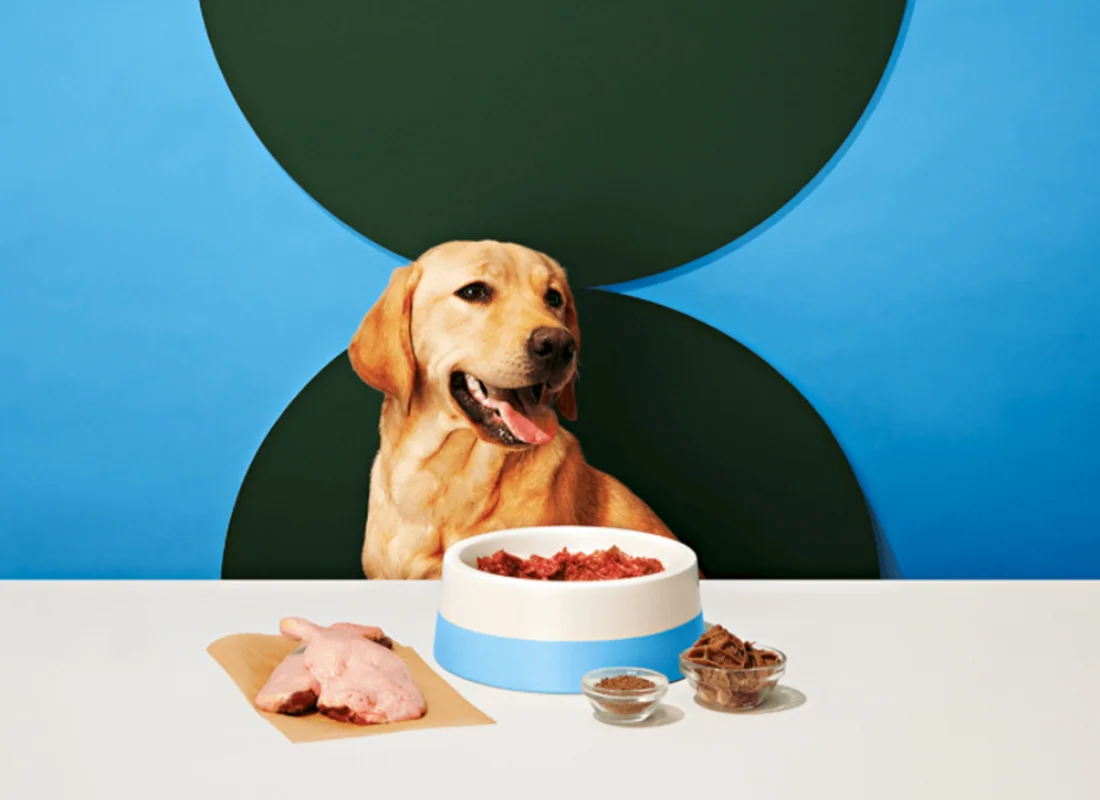[vc_row][vc_column][vc_column_text css=””]
We all experience allergies at some point in our lives. Whether they’re food related, seasonally charged, or from something completely unique to you, we’re all prone to having them and that’s no different for our four-legged friends.
Finding what causes or triggers allergies in dogs will always vary from pet to pet, but a healthy and well-balanced diet is a great way to keep tabs on what is going into your pup’s body. Follow this guide to help manage your pet’s allergies and spot the symptoms of food allergies in dogs before they worsen.
[/vc_column_text][/vc_column][/vc_row][vc_row][vc_column][vc_row_inner content_placement=”middle”][vc_column_inner width=”1/2″][vc_column_text css=””]
How do I know if my dog has allergies?
Whether they’re newborn puppies or senior buddies, dogs of all ages can experience allergies. As your dog’s best friend, you’ll be able to tell if they’re going through an allergic period by the symptoms they display.
Allergies can be caused by all sorts of things, but the list of symptoms tends to be a lot more narrow. Symptoms can include watery or itchy eyes, digestive upset, itchy skin, irritated paws, and inflammation or skin irritation. [/vc_column_text][/vc_column_inner][vc_column_inner width=”1/2″][vc_column_text css=””]
What causes allergies in dogs?
When it comes to allergies, dogs can experience them the same way that people do. Their environment, the things they eat, and even certain bugs can get them itching all over.
[/vc_column_text][/vc_column_inner][/vc_row_inner][vc_row_inner content_placement=”middle”][vc_column_inner width=”1/2″][vc_column_text css=””]
Environment
Like us, the space and environment that your dog is in will have an effect on their body. If something isn’t agreeing with them, the alarms will go off and trigger a reaction. Pollen, certain fabrics, and cleaning products are all things to watch out for as they can all cause allergies![/vc_column_text][/vc_column_inner][/vc_row_inner][vc_row_inner content_placement=”middle”][vc_column_inner width=”1/2″][vc_column_text css=””]
Fleas
This probably isn’t news to you, but fleas are a common problem for both cats and dogs. Flea’s saliva provokes the release of a histamine-like compound which causes your dog’s skin to become extremely itchy.
According to Dogs Naturally, flea allergy dermatitis can be triggered by just a couple of bites and the affected areas around the base of the tail will show symptoms of red or scabby skin.[/vc_column_text][/vc_column_inner][/vc_row_inner][vc_row_inner content_placement=”middle”][vc_column_inner width=”1/2″][vc_column_text css=””]
Food
If a dog has a dog food allergy or any sort of intolerance to an ingredient in its diet, its body will throw up some red flags. Did you know that traditional kibbles and dry foods can contain up to 30 ingredients? That’s a lot of components going into one little pebble of food and makes it very difficult to narrow down which ingredient triggered the reaction.
Some of the most common dog food allergies are to specific proteins, but certain artificial preservatives, fillers, and dyes can cause reactions, too.
[/vc_column_text][/vc_column_inner][/vc_row_inner][vc_column_text css=””]
Are there differences between dog food allergies and sensitivities?
Yes! Although they may seem very similar, it is crucial for pet owners to know the difference between a dog food allergy and a sensitivity. Talking to your holistic veterinarian can help you understand the differences in depth, but we can give you a surface-level explanation below.
[/vc_column_text][vc_row_inner content_placement=”middle”][vc_column_inner width=”1/2″][vc_column_text css=””]
Dog food sensitivities.
Also known as food intolerance, this happens when a food ingredient or substance irritates your dog’s digestive system rather than causing a full-blown reaction. Much like dairy makes some people have tummy aches, dogs can experience similar issues like yeast sensitivities. Certain foods could cause your dog an upset stomach and require more trips to the bathroom.[/vc_column_text][/vc_column_inner][vc_column_inner width=”1/2″][vc_column_text css=””]

Dog food allergies.
In most cases, common dog food allergies are more severe than their sensitive counterparts. A dog food allergy is usually an immune system response to a food that the body thinks is harmful, often a specific protein. Symptoms of food allergies in dogs can show up as wheezing, skin eruptions, itching, or even swelling.
In most cases, the American Kennel Club says that if your pet has a food allergy, dog symptoms may include:
- Itchiness
- Hives
- Swelling in the face area
- Digestive upset
- Sneezing
- Chronic ear infections
- Constant licking
[/vc_column_text][/vc_column_inner][/vc_row_inner][vc_column_text css=””]
How to check if a dog has allergies?
If you suspect your dog may be experiencing any sort of sensitivity or allergies, the easiest thing you can do is start an elimination diet, which is basically a dog food allergy test! Let us explain.
Imagine you’re ordering yourself a delicious gumbo with all the fixings. It’s packed with various types of meat, veggies, and an array of other ingredients. Not too long after you begin digging in, you’ve broken out in hives and you start questioning why. Well, the answer is probably buried in that tasty bowl of soup.
When loads of ingredients are jammed into a meal, it can be very difficult to track down which one caused the reaction. The same thing goes for dogs eating dry food. As we previously said, these traditional dog foods can contain upwards of 30 ingredients, including multiple meat sources, carbohydrates, preservatives, and additional flavourings. You’ll want to remove the majority of those to get down to the bottom of the allergies.
[/vc_column_text][vc_row_inner content_placement=”middle”][vc_column_inner width=”1/2″][vc_column_text css=””]
Elimination diets for dogs.
This is one of the most effective ways to determine if your dog is suffering from a food allergy or sensitivity. By feeding a specific protein rather than a mixture of them, it becomes easier to rule out the ones that disagree with your pet.
With that said, you can start by feeding your dog a single-protein diet over time while removing all others. You should continue this process for 8-12 weeks, and although that may seem like a lifetime, food allergy dog symptoms can take a while to reveal themselves.
If symptoms appear within 14 days, you’ve successfully found the culprit that has been causing the allergies and should quit feeding that protein to your dog immediately. If no symptoms present themselves, you can continue this dog food allergy test with various proteins.
Symptoms can take up to 10 weeks to go away, but in doing so, you should be able to find a food that works best with your dog. Please note that an elimination diet requires you to feed nothing but the protein you’re testing. That means avoiding adding anything else to the mix, even your dog’s favourite treats (sorry to all the good dogs out there).
If your pet’s allergy to dog food persists and you find yourself wondering “how long for this dog food allergy to clear up”, it may be time to check in with your holistic veterinarian.[/vc_column_text][/vc_column_inner][vc_column_inner width=”1/2″][vc_column_text css=””]
What food should I feed my dog with allergies?
The best dog food for allergies would have to be low-glycemic, single-ingredient diets, or a raw dog food diet.
When beginning an elimination diet with your dog, we typically recommend our Bold by Nature Pure Pork or Pure Duck formulas, as they only contain meat, bone, and organ. This way you’re starting with a simple one-protein blend that contains nothing but a few nutritious ingredients.
Once you’ve tested one of the proteins and everything is going swimmingly with your dog, you can move on to a similar formula, only this time with vegetables. For example, if you’ve been feeding our Pure Duck, you can try feeding Mega Duck for dogs after the elimination period to see if your dog has any sensitivities to kelp or veggies.
Both of our formulas are low glycemic, but our Select formula does not contain any vegetables. This being said, our Select formula contains beef tripe, so if your dog has a beef allergy, it is best to avoid this option.
Again, the best dog food for allergies contains a limited ingredient, all-natural diet. Each raw recipe is formulated as nature intended, but the benefits of raw dog food go beyond just the essential nutrients they contain.
[/vc_column_text][vc_row_inner content_placement=”middle”][vc_column_inner width=”1/2″][vc_column_text css=””]
What is the best way to switch my dog’s food?
If you want to transition your dog over to a raw diet, the best way to do it is by going cold turkey. No, we mean it. Our Bold by Nature Turkey formulas for dogs are a great way to start your pup on its raw adventure as it’s an easier protein to digest. If you’re wondering how to feed a dog raw food, you can combine a protein like turkey with smaller, more frequent meals throughout the day to allow your dog to adjust to it easier. If your dog already has digestive issues, we suggest having them fast for a whole 24 hours before switching them over to their new raw diet.[/vc_column_text][/vc_column_inner][vc_column_inner width=”1/2″][vc_column_text css=””]

Can a dog develop an allergy to its food over time?
Yes, it definitely can! Just like us humans, our favourite foods can one day become a meal of the past thanks to pesky allergies. You could go 30 years eating nuts and develop an allergy to them out of the blue.
Dogs are very similar and can develop allergies as they age. This can happen especially when they are not fed a variety of proteins. In other instances, some dogs will even develop an allergy to a protein they are fed regularly. [/vc_column_text][/vc_column_inner][/vc_row_inner][vc_row_inner content_placement=”middle”][vc_column_inner width=”1/2″][vc_column_text css=””]
How do I best choose a diet for my dog with allergies?
If you’re looking for the best dog food for allergies, ask yourself these questions before you buy.
What proteins are used?
Often times, proteins are the cause of your dog’s allergy symptoms, so this is the most important thing to consider. Look for limited-ingredient foods and diets that contain a single-animal protein, like one of our Bold by Nature formulas.
Where are the ingredients sourced?
It’s always good to be aware of where your dog’s food is coming from. This way you’ll know if it has been in contact with potential allergens so you can avoid any reactions or symptoms.
Are there additives in the diet?
The fewer ingredients the better! Things like wheat and dairy can cause reactions in your dog’s system, so they’re best to be avoided.
Does it contain any fillers?
Like additives, fillers in your dog’s diet like potatoes, cornmeal, or other starchy carbs can lead to some unwanted symptoms. You can never go wrong with a grain-free diet.[/vc_column_text][/vc_column_inner][vc_column_inner width=”1/2″][vc_column_text css=””]
Where can I get Bold by Nature products?
You can purchase Bold by Nature+ products at your local retailer. If you’re not sure where to buy raw pet food, you can use our location finder to explore retailers near you that carry Bold by Nature products, like raw pet food in Canada.
[/vc_column_text][/vc_column][/vc_row]













